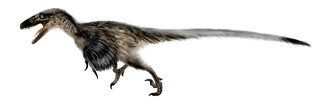Utahraptor ostrommaysorum

Name: Utahraptor ostrommaysorum
(Pronunciation: YOU-tah-WRAP-tore ah-STROM-ay-SORE-um)
Age: Early Cretaceous (~125 million years ago)
Where It's Found in Utah: Dalton Wells Quarry and Gaston Quarry, near Moab, Grand County, Utah.
Geologic Formation: Cedar Mountain Formation (Yellow Cat Member)
Classification: Saurischia – Theropoda – Coelurosauria - Dromaeosauridae
Description: Utahraptor ostrommaysorum is one of the geologically oldest and largest known dromaeosaurids. This group of carnivorous dinosaurs had a large retractable sickle claw on its foot, specialized for cutting. With a name meaning “Utah’s predator,” Utahraptor was a ferocious hunter that used its sickle-shaped claws to attack and rip apart its prey. The claw itself was 9.5 inches (24 cm) long! The species name ‘ostrommaysorum’ honors Dr. John Ostrom of Yale University for his pioneering research linking carnivorous dinosaurs to the ancestry of birds. Utahraptor was the inspiration for the Velociraptors in the film Jurassic Park! Utahraptor, however, was quite a bit bigger than Velociraptor; adults were around 20 feet (6.1 meters) long and around 5 feet (1.5 meters) tall at the hip.
Why It’s a Top NHMU Dinosaur: Prior to the discovery of Utahraptor, paleontologists believed sickle-clawed dromaeosaurids were small carnivores that only lived in the Late Cretaceous. Utahraptor required paleontologists to revise their understanding of this family of dinosaurs as it was much larger and lived the Early Cretaceous. In addition, Utahraptor is closely related to birds. Dromaeosaurids, troodontids (small bipedal theropod feathered dinosaurs that also had a sickle claw on the foot), and the ancestors of modern birds all reside on the same branch of the dinosaur family tree. It may be hard to think of something so large and ferocious as being related to birds. A decrease in body size had to occur for these animals to evolve flight and to resemble more closely the birds we see today. Although dromaeosaurids died out some 65.5 million years ago, their close relatives survived and became remarkably successful. Remember, not all dinosaurs went extinct!
Where Can I See It?: The Past Worlds Gallery at the Natural History Museum of Utah; Brigham Young University Museum of Paleontology; USU Eastern Prehistoric Museum.
Suggested Reading/References:
Early Cretaceous dinosaurs of Utah - Utah Geological Survey
Britt, B. B., D. J. Chure, K. L. Stadtman, J. H. Madsen, Jr., R. D. Scheetz, and D. L. Burge. 2001. New osteological data and the affinities of Utahraptor from the Cedar Mountain Fm (Early Cretaceous of Utah). Journal of Vertebrate Paleontology 21:36A.
Kirkland, J. I., D. Burge, and R. Gaston. 1993. A large dromaeosaur (Theropoda) from the Lower Cretaceous of eastern Utah. Hunteria 2:1-16.
Kirkland, J. I., and S. K. Madsen. 2007. The Lower Cretaceous Cedar Mountain Formation, eastern Utah: the view up an always interesting learning curve. Utah Geological Association Publication 35:1-108.
Credits:
Image: © Victor Leshyk
Author: Carolyn Levitt, Paleontology Graduate Student at the Natural History Museum of Utah (2012)